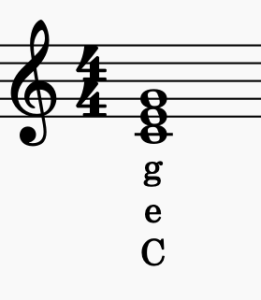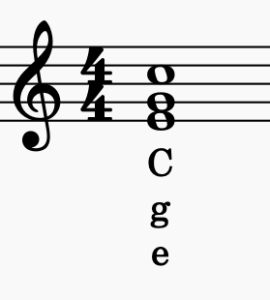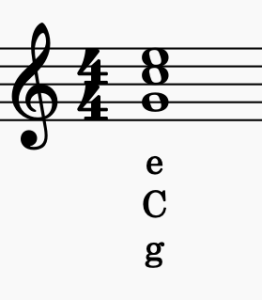As you embark on your musical journey, understanding the fundamentals of chords, inversions, and voicings is essential for unlocking the full potential of the piano and enhancing your playing skills.
Understanding Chords
Let’s start with the basics: what exactly is a chord?
At its core, a chord is a group of two or more notes played simultaneously. Chords are typically constructed by stacking intervals of thirds on top of each other, resulting in a variety of chord types with distinct sounds and characteristics. Chords serve as the building blocks of harmony across various genres.
The three main types of triads are major, minor, and diminished, each conveying different emotions and moods. They each consist of a root, a third, and a fifth, which we will come to later in this article.
- Major chords
Major chords have a major third (two whole tones) interval between the root (tonic) and third degree of the chord, and a minor third (tone and a half) interval between the third and fifth intervals of the chord. They exude brightness and positivity, often associated with feelings of happiness or contentment. - Minor chords
Minor chords have a minor third (tone and a half) interval between the root (tonic) and third degree of the chord, and a major third interval between the third and fifth intervals. They evoke a sense of melancholy and introspection, adding depth and emotion to music. - Diminished chords
Diminished chords are made up of minor thirds stacked on top of one another. They create tension and suspense, adding a touch of drama and unease to musical compositions.
Exploring Chord Inversions
Chord inversions refer to different arrangements of the same set of notes within a chord. While the notes remain the same, their order and positioning on the keyboard change, resulting in a different sound and feel. By rearranging the notes, you can create smoother transitions between chords and avoid awkward hand movements. Inversions also add variety and interest to your playing.
Inversions are particularly useful for maintaining smooth voice leading, minimising the distance traveled by individual notes when moving from one chord to another. They also allow for greater musical expression, as different inversions of the same chord can evoke different emotions and moods.
To create inversions, you simply take the notes of a chord and rearrange them so that a different note becomes the lowest or bass note of the chord. This alters the chord’s harmonic structure, adding variety and interest to your playing.
For example, let’s take a C major chord (C-E-G). In its root position, the C note is the lowest note:

But if we move the C note up an octave, the chord is now in its first inversion, with the E note as the lowest note (and G and C above):

And if we move the E note up an octave, the chord is in its second inversion, with the G note as the lowest note (and C and E above):

Why Invert?
Inverting chords serves several important purposes. By using inversions, you can create smoother transitions between chords, avoid awkward hand movements, and add a sense of flow and continuity to your playing.
- Smooth Voice Leading:
Inversions allow for smoother transitions between chords by minimizing the distance traveled by individual notes. When moving from one chord to another, keeping common tones between chords or moving notes by step (rather than by larger intervals) creates a smoother and more pleasing sound. - Avoiding Awkward Hand Movements:
In some cases, playing chords in their root position may require awkward hand stretches or leaps, especially when transitioning between chords rapidly. Inversions can help alleviate this issue by rearranging the notes in a chord to a more comfortable and ergonomic position on the keyboard. - Enhancing Musical Expression:
Inversions can alter the harmonic color and texture of a chord, providing variety and interest to your playing. Different inversions of the same chord can evoke different moods or emotions, allowing for greater musical expression and creativity. - Balancing the Sound:
In ensemble playing, using inversions can help balance the overall sound by distributing the notes of a chord across different registers of the keyboard or different instruments. This ensures that no single instrument or voice dominates the texture, resulting in a more cohesive and harmonious performance.
Chord Voicings
Chord voicings refer to the specific arrangement or spacing of the notes within a chord. Experimenting with different voicings allows you to create unique and expressive interpretations of chords, enhancing your playing with depth and character. Voicings can vary in octave placement, doubling of notes, and overall distribution of notes across the keyboard.
Whether you’re clustering notes closely together for a more intimate sound or spreading them out across the keyboard for a fuller and more resonant sound, chord voicings provide endless opportunities for creativity and self-expression.
As you practice chords, inversions, and voicings, remember to start with basic concepts and gradually progress to more advanced techniques. Regular practice and experimentation will help you master these essential skills and enhance your piano playing abilities.
By understanding chords, inversions, and voicings, you’ll be better equipped to interpret and perform a wide range of musical pieces with confidence and skill.

